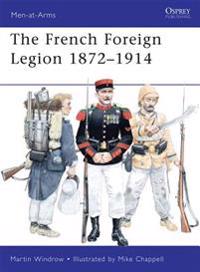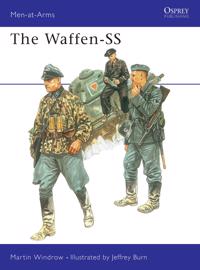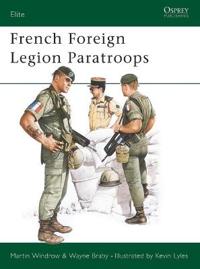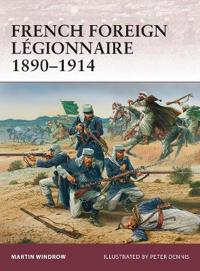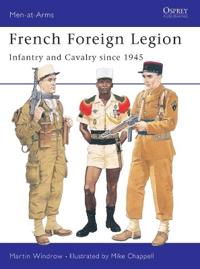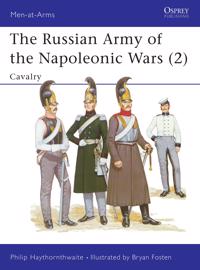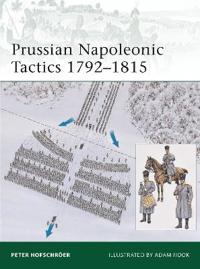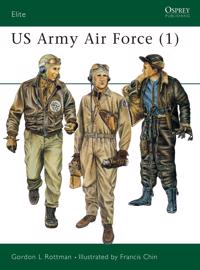The French Foreign Legion 1872-1914 (Pocket)
avMartin Windrow, Mike Chappell, Martin Windrow
ISBN: 9781849083263 - UTGIVEN: 201007This volume covers the classic 'Beau Geste' period, of the French Foreign Legion when the corps was expanded during the most dynamic years of French imperial expansion. Legion battalions fought in the deserts and mountains of southern Algeria and Morocco, as well as in the jungles of North Vietnam, [...]
The Last Valley (Häftad)
avMartin Windrow
ISBN: 9780304366927 - UTGIVEN: 2005-02Stalingrad in the jungle: the battle that doomed the French Empire and led America into Vietnam In winter 1953-54 the French army in Vietnam challenged its elusive enemy, General Giap's Viet Minh, to pitched battle. Ten thousand French paras and legionnaires, with artillery and tanks, were flown to [...]
The Last Valley (Häftad)
avMartin Windrow
ISBN: 9780306814433 - UTGIVEN: 2005-12In December 1953 French paratroopers, who had been searching for the elusive Vietnamese army, were quickly isolated by them and forced to retreat into their out-gunned and desolate jungle base-a small place called Dien Bien Phu. The Vietnamese besieged the French base for five long and desperate mo[...]
The Owl Who Liked Sitting on Caesar: Living with a Tawny Owl (Inbunden)
avMartin Windrow, Christa Hook
ISBN: 9780374228460 - UTGIVEN: 2014-06The story of an odd couple--a British military historian and the Tawny Owl with whom he lived for fifteen years
Martin Windrow was a war historian with little experience with pets when he adopted an owl the size of a corncob. Adorable but with knife-sharp talons, Mumble became Windrow's closest,[...]The Owl Who Liked Sitting on Caesar (Storpocket)
avMartin Windrow
ISBN: 9780552170048 - UTGIVEN: 2014-10'Perched on the back of a sunlit chair was something about 9 inches tall and shaped rather like a plump toy penguin with a nose-job. It appeared to be wearing a one-piece knitted jumpsuit of pale grey fluff with brown stitching, complete with an attached balaclava helmet. From the face-hole of the f[...]
Our Friends Beneath the Sands (Storpocket)
avMartin Windrow
ISBN: 9780753828564 - UTGIVEN: 201104Ever since the 1920s the popular legend of the French Foreign Legion has been formed by P.C. Wren's novel BEAU GESTE - a world of remote forts, warrior tribes, and desperate men of all nationalities enlisting under pseudonyms to fight and die under the desert sun. As with all cliches, the reality is[...]
The Waffen-SS (Häftad)
avMartin Windrow
ISBN: 9780850454253 - UTGIVEN: 1992-03In the early 1920s, a tiny group was formed within the SA to serve as Hitler's personal bodyguard. Originally labelled the "Stosstruppe Adolf Hitler," they later became known as the SS - Schutz Staffeln, or "protection squads." From these humble beginnings, the SS rose to a nominal strength of 38 di[...]
French Foreign Legion Paratroopers (Häftad)
avMartin Windrow, W. Braby
ISBN: 9780850456295 - UTGIVEN: 198509The decision, in Spring 1948, to form two battalions of Foreign Legion paratroopers was prompted by the requirement for enlarged airborne forces in the First Indochina War (1946), and the healthy recruitment then employed by the Legion. There were some initial doubts. The Legion were known to be mag[...]
French Foreign Legion (E-bok)
avMartin Windrow
ISBN: 9781472805294Men of action and elite soldiers with a young and dynamic spirit, the French Foreign Legion are capable of doing their duty anywhere anytime. Martin Windrow's superb text examines the history of this famous force from the end of the Second World War onward. This first class addition to the Men-at-Ar[...]
French Foreign Legionnaire 1890-1914 (Häftad)
avMartin Windrow
ISBN: 9781849084222 - UTGIVEN: 2011-08"French Foreign Legionnaire 1890-1914".
French Foreign Legion Since 1945 (Häftad)
avMartin Windrow
ISBN: 9781855326217 - UTGIVEN: 199611Men of action and elite soldiers with a young and dynamic spirit, the French Foreign Legion are capable of doing their duty anywhere anytime. Martin Windrow's superb text examines the history of this famous force from the end of the Second World War onward. This first class addition to the Men-at-Ar[...]
The Algerian War, 1954-62 (Häftad)
avMartin Windrow, Mike Chappell
ISBN: 9781855326583 - UTGIVEN: 1997-11In the mid-1950s to early 1960s the Algerian war dominated the European press, comparable in impact to the Vietnam War. France was divided politically, and governments rose and fell regularly. Algeria was France's oldest, richest and most integrated colony, but during the war in Indochina an undergr[...]
The Indochina War, 1946-54 (Häftad)
avMartin Windrow
ISBN: 9781855327894 - UTGIVEN: 199811The states of Indochina had been French colonies or protectorates since the 19th century. However, in March 1945 the Japanese interned all French troops and officials, and turned over all civil government to local authorities. The power vacuum caused by the Japanese surrender allowed the Viet Minh, [...]
The Russian Army of the Napoleonic Wars (2) (Pocket)
avPhilip J. Haythornthwaite, Martin (EDT) Windrow, Philip J. Haythornthwaite
ISBN: 9780850457469 - UTGIVEN: 1987-07During the Napoleonic era, Russia possessed a vast force of cavalry, forming a greater percentage than that of most European armies. This stemmed partly from their service against the Turks, who had huge numbers of troops, and partly from the fact that much Russian terrain was suitable for the manoe[...]
Prussian Napoleonic Tactics 1792-1815 (Pocket)
avPeter Hofschroer, Adam (ILT) Hook, Martin (EDT) Windrow
ISBN: 9781846035098 - UTGIVEN: 2011-10"Prussian Napoleonic Tactics: 1792-1815".
Us Army Air Force (Pocket)
avGordon Rottman, Martin (EDT) Windrow, Gordon Rottman
ISBN: 9781855322950 - UTGIVEN: 1993-05In June 1941 the US Army's air organisations were consolidated under a single command, the Army Air Forces or AAF. Its expansion was rapid and massive, and its contribution to the war effort was substantial. Books abound describing the AAF's impressive combat record, but little has been published to[...]

